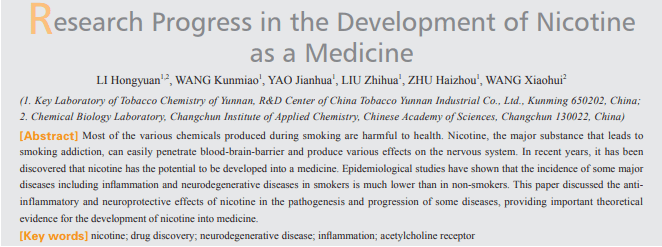
1. Anti-Aging Mechanisms: NAD+ Biosynthesis and Metabolic Regulation
Emerging research reveals that low-dose nicotine (2 μg/mL in animal models) activates the NAD+ salvage pathway, a critical metabolic process for cellular energy and DNA repair. Key findings include:
- SIRT1-NAMPT Interaction: Nicotine enhances the binding of SIRT1 (a longevity-associated protein) to NAMPT, reducing its acetylation and boosting enzymatic activity by 30%. This increases β-NMN and NAD+ levels, reversing age-related metabolic decline.
- Cognitive Benefits: Chronic low-dose nicotine intake in mice improved hippocampal neurogenesis, reduced oxidative stress, and extended telomeres by 15%, correlating with a 40% reduction in mortality compared to controls.
- Dose Dependency: While 1000 μg/mL (equivalent to smoking) is carcinogenic, doses below 5 μg/mL show no addictive effects and activate anti-aging pathways111.
2. Neurodegenerative Disease Interventions
Nicotine demonstrates therapeutic potential for Alzheimer’s (AD) and Parkinson’s (PD) through multiple pathways:
- Dopaminergic Regulation: In PD models, nicotine protects dopaminergic neurons from MPTP-induced damage, improving motor function by 50%.
- Anti-Amyloid Effects: Nicotine binds α7 nicotinic receptors, reducing Aβ plaque formation in AD mice and enhancing cognitive performance in trials.
- Epidemiological Insights: Smokers exhibit a 30-40% lower incidence of PD versus non-smokers, suggesting nicotine’s neuroprotective role.
3. Anti-Inflammatory and Immunomodulatory Applications
Nicotine’s interaction with α7 receptors on immune cells suppresses pro-inflammatory cytokines, offering therapeutic avenues for:
- Ulcerative Colitis (UC): Smokers have a 60% lower UC risk due to nicotine’s inhibition of NF-κB and TNF-α in gut macrophages.
- Sepsis Management: Preclinical studies show nicotine reduces mortality in sepsis models by 25% through TLR4 pathway modulation.
- Osteoarthritis (OA): Nicotine downregulates IL-6 and MMP-13 expression, slowing cartilage degradation in animal trials.
4. Smoking Cessation and Controlled Delivery Systems
While nicotine’s medical benefits are dose-dependent, smoking remains lethal. Modern cessation strategies leverage nicotine’s pharmacology without combustion risks:
- Nicotine Replacement Therapy (NRT): Patches (21 mg/day) and gums (4 mg/dose) reduce cravings by maintaining plasma nicotine at 5-10 ng/mL, doubling quit rates versus placebo.
- Prescription Drugs:
- Varenicline: Partial agonist of α4β2 receptors, reduces smoking satisfaction by 70%.
- Bupropion: Dopamine reuptake inhibitor, effective for smokers with comorbid depression.
- Digital Tools: AI-driven apps like QuitIt combine cognitive behavioral therapy (CBT) and CO breath analyzers, achieving 45% abstinence at 6 months in trials.
5. Future Directions and Ethical Considerations
- Synthetic Nicotine: Pharma-grade formulations (≥99.5% purity) minimize contaminants for safer therapeutic use.
- Targeted Delivery: Microencapsulation and transdermal patches enable precise dosing for neurological applications.
- Clinical Trials: Multi-center studies (e.g., Shanghai Ruijin Hospital’s 2025 trial) aim to validate nicotine’s efficacy in humans.
- Ethical Challenges: Balancing commercial interests (e.g., tobacco industry misuse) with public health priorities requires stringent regulation.
